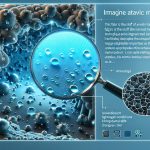Are you curious about the latest advancements in fabric technology? Look no further!
In this ultimate guide, we’ll explore the exciting world of sustainable textiles, smart fabrics, nanotechnology, biodegradable materials, 3D printing, and advanced performance fabrics.
Discover how these innovations are revolutionizing the way we think about and interact with fabrics.
Get ready to be amazed by the possibilities that lie ahead in the world of fabric technology.
Table of Contents
Sustainable Textiles
In this section, we’ll explore the advancements in fabric technology that enable you to make more sustainable choices when it comes to textiles.
One important aspect of sustainable textiles is the use of recycled fibers. By incorporating recycled fibers into fabrics, manufacturers are able to reduce the demand for virgin materials, saving energy and resources in the process. These recycled fibers can come from a variety of sources, such as post-consumer waste like plastic bottles or discarded clothing. By giving new life to these materials, we can reduce the amount of waste that ends up in landfills.
Another important technique in sustainable textiles is upcycling. Upcycling involves transforming waste materials or unwanted garments into new and improved products. Instead of throwing away old clothes, for example, they can be repurposed into new garments or accessories. This not only reduces waste but also extends the lifespan of the materials, reducing the need for new production. Upcycling also allows for creativity and uniqueness in fashion, as each upcycled piece becomes one-of-a-kind.
Smart Fabrics
Discover the endless possibilities of smart fabrics with their integration of cutting-edge technology.
Smart fabrics, also known as interactive textiles, are revolutionizing the fashion and textile industry. These innovative materials go beyond traditional fabrics by incorporating wearable technology that can interact with the wearer and the environment.
Here are three key features of smart fabrics:
-
Sensor Technology: Smart fabrics are equipped with sensors that can detect and measure various physical attributes such as temperature, pressure, and movement. These sensors can provide valuable data to the wearer, allowing them to monitor their health and well-being in real-time.
-
Connectivity: Smart fabrics can connect to other devices such as smartphones or smartwatches, enabling seamless communication and integration with other technologies. This connectivity allows for personalized experiences and the ability to control various functions through the fabric itself.
-
Adaptive Functionality: Smart fabrics have the ability to adapt to different conditions and requirements. For example, they can regulate body temperature by adjusting the fabric’s insulation properties. Additionally, smart fabrics can change color or pattern based on external factors or user preferences, adding a dynamic and customizable element to clothing.
With their integration of wearable technology and interactive capabilities, smart fabrics are transforming the way we think about and interact with clothing. From fitness tracking to personalized style preferences, the future of fashion lies in the innovative possibilities of smart fabrics.
Nanotechnology in Fabrics
Let’s explore the exciting world of nanotechnology in fabrics. Nanotechnology brings enhanced properties to fabrics, making them more durable, lightweight, and resistant to stains and wrinkles.
With smart textiles applications, nanotechnology opens up a new realm of possibilities, from self-cleaning fabrics to temperature-regulating clothing.
The future of nano-fabrics is promising, revolutionizing the way we interact with and benefit from our clothing.
Enhanced Fabric Properties
Explore the remarkable advancements in fabric technology through the integration of nanotechnology, allowing you to witness the transformation of fabric properties like never before. Nanotechnology has revolutionized the textile industry, enabling the creation of fabrics with enhanced properties that were once unimaginable.
Here are three exciting ways nanotechnology has improved fabric properties:
-
Water resistant fabrics: Nanotechnology has introduced a new era of water repellency. By applying nanocoatings to fabric surfaces, water droplets bead up and roll off, keeping you dry even in the wettest conditions. This breakthrough technology ensures that the fabric remains breathable while providing excellent protection against water.
-
Antimicrobial textiles: Nanoparticles with antimicrobial properties can be embedded in fabrics, preventing the growth of bacteria and eliminating odors. This innovation is particularly beneficial in clothing and bedding, where bacteria can thrive and cause unpleasant smells. With antimicrobial textiles, you can enjoy fresh and odor-free garments for longer periods.
-
Self-cleaning fabrics: Nanotechnology has paved the way for self-cleaning fabrics that repel dirt and stains. By incorporating nanostructures into the fabric, dirt particles can’t adhere to the surface, making it easier to clean and maintain. This breakthrough not only saves time and effort but also prolongs the lifespan of your garments.
Thanks to nanotechnology, fabric properties have been enhanced to provide greater comfort, functionality, and durability.
Smart Textiles Applications
Nanotechnology has revolutionized fabric technology, bringing about a new era of smart textiles applications that enhance functionality and performance.
One of the most exciting developments in this field is the integration of wearable technology into fabrics. With the help of nanotechnology, fabrics can now incorporate sensors and electronic components that can monitor various aspects of your health and well-being. These textile sensors can measure heart rate, body temperature, and even track your movements. They can provide valuable data to help you optimize your workout, prevent injuries, and improve your overall performance.
Imagine wearing a shirt that can detect your stress levels and provide relaxation techniques or a pair of pants that can monitor your posture and remind you to sit up straight. Thanks to nanotechnology, these innovations in smart textiles are becoming a reality.
Future of Nano-Fabrics
As we delve into the future of nano-fabrics, you’ll discover how nanotechnology continues to transform the textile industry, enabling advancements that enhance functionality and performance. Nano fabric applications are revolutionizing the way we think about clothing and textiles.
Here are three exciting developments in nanotechnology advancements for fabrics:
-
Enhanced durability: Nano-coatings can be applied to fabrics to make them more resistant to stains, water, and UV rays. This not only extends the lifespan of the fabric but also reduces the need for frequent washing and maintenance.
-
Improved comfort: Nanofibers can be woven into fabrics to create materials that are lightweight, breathable, and moisture-wicking. These fabrics allow for better temperature regulation and sweat absorption, keeping you cool and dry even during intense physical activity.
-
Antibacterial properties: Nanoparticles can be incorporated into fabrics to inhibit the growth of bacteria and reduce odors. This is especially beneficial for sportswear and active wear, where bacteria buildup can lead to unpleasant smells.
With ongoing advancements in nanotechnology, the future of nano-fabrics holds immense potential for creating innovative and functional textiles.
Biodegradable and Compostable Materials
Let’s talk about the environmental impact of biodegradable materials. These materials are designed to break down naturally over time, reducing the amount of waste that ends up in landfills. They can be made from a variety of sources, including plants, animals, and even certain types of plastics. By using biodegradable materials, we can help to reduce pollution and conserve resources.
Now, let’s discuss the benefits of using compostable fabrics. Compostable fabrics are made from natural materials that can be broken down into compost. This means that when these fabrics are no longer usable, they can be returned to the earth and used to nourish plants and soil. Compostable fabrics are a sustainable alternative to traditional synthetic fabrics, which can take hundreds of years to break down.
Lastly, let’s talk about the future of sustainable textiles. As the demand for eco-friendly products continues to grow, the textile industry is exploring new ways to create sustainable fabrics. This includes developing new fibers that are biodegradable, compostable, or made from recycled materials. The future of sustainable textiles is bright, with companies and consumers alike recognizing the importance of reducing waste and preserving the environment.
You’ll discover how these innovations are helping to reduce waste and pollution in the fashion industry. From biodegradable fibers to compostable packaging, these materials are paving the way for a more eco-friendly future.
Environmental Impact of Biodegradables
Explore the environmental impact of biodegradables, such as biodegradable and compostable materials, to understand their contribution towards sustainability. When it comes to finding alternatives to traditional plastics, biodegradable options have gained significant attention. These materials have the ability to break down naturally over time, reducing their impact on the environment.
Here are three key points to consider:
-
Biodegradable plastic alternatives: Biodegradable materials offer a promising solution to reduce plastic waste. These alternatives can be made from plant-based sources, such as corn or sugarcane, and are designed to biodegrade in natural conditions. By choosing these alternatives, you can help combat the pollution caused by conventional plastics.
-
Eco-friendly fabric options: Biodegradable and compostable materials are also making their way into the textile industry. Fabrics made from natural sources like bamboo, hemp, or organic cotton can decompose without causing harm to the environment. By opting for these eco-friendly fabric options, you can support sustainable fashion practices and reduce waste.
-
Sustainable disposal methods: Proper disposal of biodegradable and compostable materials is crucial for their environmental impact. Composting these materials in dedicated facilities ensures that they break down efficiently, returning valuable nutrients to the soil. It’s important to follow local guidelines and regulations for the appropriate disposal of these materials to maximize their sustainability benefits.
Benefits of Compostable Materials
Discover the numerous advantages of using compostable materials in fabric technology. Compostable packaging and biodegradable fashion are revolutionizing the industry, offering a sustainable alternative to traditional materials.
One of the key benefits of compostable materials is their positive environmental impact. Unlike non-compostable materials, compostable materials break down naturally into organic matter, leaving no harmful residue behind. This means that when compostable fabrics are disposed of, they can be returned to the earth and contribute to the growth of new plants and trees.
Additionally, using compostable materials reduces the amount of waste that ends up in landfills, helping to combat the global waste crisis.
Future of Sustainable Fabrics
In the future of sustainable fabrics, you can expect to see advancements in biodegradable and compostable materials. These innovations will contribute to a circular economy in fabric production, allowing materials to be reused and recycled rather than ending up in landfills.
Additionally, sustainable dyeing techniques will be developed to minimize the environmental impact of textile coloring processes. These techniques will use natural dyes, low-impact dyes, or even innovative methods like digital printing, which eliminates the need for excessive water and chemical usage.
3D Printing in Fabric Production
When incorporating 3D printing in fabric production, you can achieve intricate designs and precise detailing.
3D printing applications have revolutionized the textile industry by offering new possibilities in design and manufacturing.
Digital textile printing, which involves printing designs directly onto fabrics using inkjet technology, has been widely adopted in recent years.
However, 3D printing takes fabric production to another level by allowing the creation of three-dimensional structures and textures.
With this technology, you can produce fabrics with complex patterns, raised surfaces, and even embedded elements such as buttons or zippers.
The ability to customize fabrics at such a detailed level opens up endless possibilities for designers and manufacturers.
Moreover, 3D printing can also enhance the functionality of fabrics by incorporating features such as moisture-wicking, antimicrobial properties, or even conductive materials for wearable technology applications.
As the technology continues to advance, we can expect to see even more innovative uses of 3D printing in fabric production, pushing the boundaries of design and functionality.
Advanced Performance Fabrics
To explore the next area of innovation in fabric technology, let’s delve into the realm of advanced performance fabrics. These fabrics have undergone significant advancements in recent years, leading to improved performance enhancements and fabric innovation.
Here are three key developments in this field:
-
Moisture-wicking fabrics: These fabrics are designed to pull moisture away from the body, keeping you dry and comfortable during physical activities. They use specialized fibers and fabric structures that quickly absorb and transport sweat to the outer surface, where it can evaporate.
-
Temperature-regulating fabrics: This type of fabric adapts to your body temperature, helping you stay cool in hot weather and warm in cold weather. Innovative technologies, such as phase-change materials or thermoregulating coatings, are incorporated into the fabric to provide optimal comfort and performance.
-
Antibacterial fabrics: With the increasing demand for hygiene and cleanliness, antibacterial fabrics have gained popularity. These fabrics are treated with special coatings or infused with antimicrobial agents to inhibit the growth of bacteria and prevent odor. They’re commonly used in sportswear, activewear, and medical textiles.
These advanced performance fabrics are revolutionizing various industries, providing athletes, outdoor enthusiasts, and everyday consumers with improved comfort, functionality, and durability. As fabric technology continues to advance, we can expect even more exciting developments in the future.
Frequently Asked Questions
How Long Does It Take for Biodegradable and Compostable Materials to Fully Decompose?
Biodegradable materials, like fabric, take varying amounts of time to decompose based on factors such as temperature and moisture. Compostable materials decompose faster, usually within a few months to a year, in the right conditions.
Are There Any Potential Health Risks Associated With Wearing Smart Fabrics?
There may be potential dangers and health concerns associated with wearing smart fabrics. It’s important to be aware of any possible risks and take necessary precautions when using these innovative materials.
What Types of Products Can Be Created Using 3D Printing in Fabric Production?
You can create a variety of products using 3D printing in fabric production. The future of 3D printed textiles is promising, with applications in fashion and beyond. The possibilities are endless!
How Does Nanotechnology Improve the Durability and Strength of Fabrics?
Nanotechnology applications enhance fabric strength by manipulating materials at a molecular level. By adding nanoparticles to fabrics, they can increase durability and strength, making them more resistant to wear and tear.
Is It Possible to Recycle Advanced Performance Fabrics?
Yes, it is possible to recycle advanced performance fabrics. However, recycling challenges arise due to the complex nature of these fabrics. Innovative recycling methods are being developed to address these challenges and promote sustainability in the textile industry.
- How Does Ring Spun Cotton Affect Garment Fit and Shape Retention? - August 13, 2024
- What Are the Challenges in Producing Ring Spun Cotton? - August 13, 2024
- Is Ring Spun Cotton Suitable for Plus-Size Clothing? - August 13, 2024





